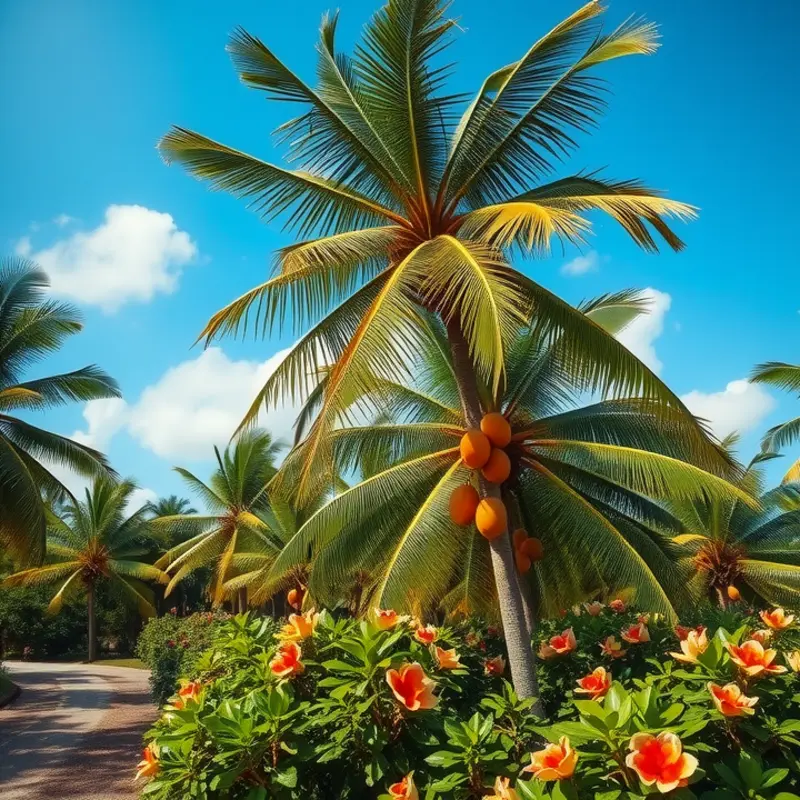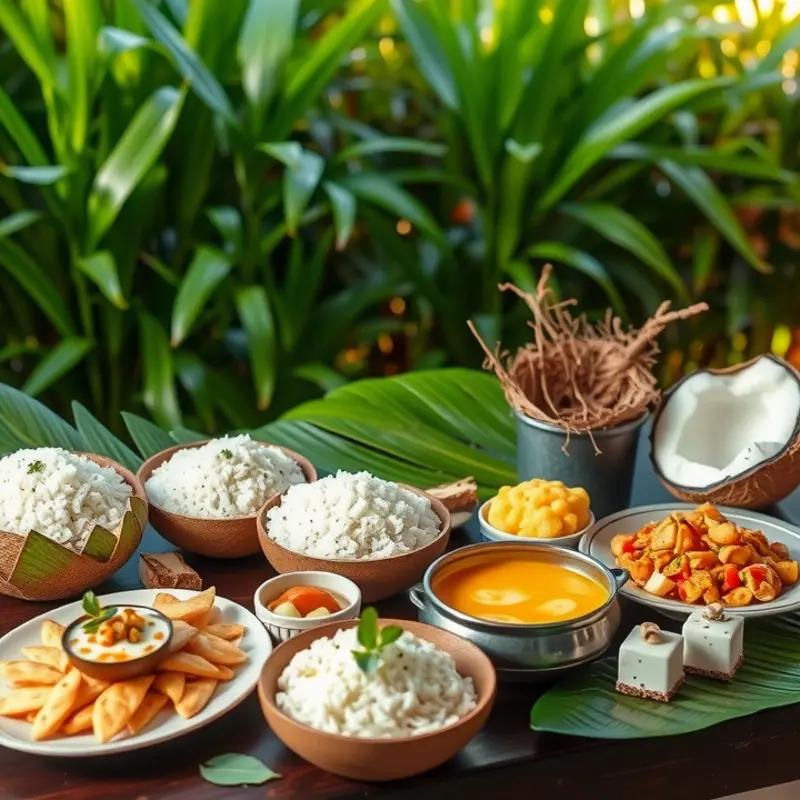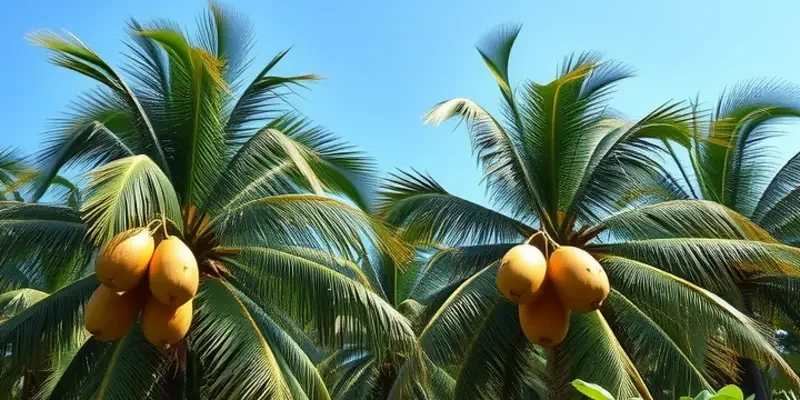Coconuts have long held a revered place in culinary practices across tropical regions. From refreshing beverages to rich curries, this versatile fruit embodies the spirit of island cooking. Delving into the vast culinary world surrounding coconuts reveals not only unique flavors but also cultural narratives shaped by generations. Join us as we journey through the culinary traditions that highlight the many uses of this tropical treasure.
Coconut Essentials: From Tree to Table

Beneath the swaying palms of tropical islands, the coconut tree thrives, an emblem of resilience and abundance. This remarkable tree, often referred to as the ‘Tree of Life,’ yields a fruit indispensable to island living and cherished in global cuisines. From its origins in the warm, humid climates of Southeast Asia and the Pacific, the coconut has journeyed across oceans, becoming a staple ingredient in diverse culinary traditions.
Each part of the coconut offers something unique. The outer husk, a fibrous shell, provides coir, used traditionally in rope-making and today in eco-friendly products. Breaking through the hard shell reveals the coconut’s prized flesh, whether firm and mature or tender like jelly in its young form. The white meat is the source of various forms of coconut used in cooking, from coconut milk and cream to coconut oil and desiccated flesh.
In the kitchen, coconuts adopt many roles. The creamy texture of coconut milk lends richness to curries, transforming simple stews into exotic feasts. Coconut oil, celebrated for its high smoke point and subtle flavor, enhances a wide range of dishes, from sautéed vegetables to baked goods. Coconut flour, a low-carb alternative to wheat flour, brings a hint of sweetness and a unique texture to desserts, making it popular among those following specialized diets. For an exploration into various dietary approaches that benefit from such versatile ingredients, you may find the seasonal ketogenic diet approach intriguing.
Harvesting coconuts is both an art and a tradition. In many tropical regions, climbers scale the towering trees, selecting coconuts at their peak of ripeness. This method, passed down through generations, supports deep-rooted community bonds. For larger operations, modern machines aid in the harvest, ensuring efficiency while maintaining quality.
The use of coconuts in cuisine reflects each culture’s unique relationship with this versatile fruit. In Indian cuisine, coconut milk is integral to the creamy dals of the southern states. In Thailand, tom kha gai, a quintessential soup, owes its aromatic allure to coconut milk’s blend with lemongrass and spices. Meanwhile, in the Caribbean, coconut adds sweetness to rice and beans, creating a signature dish known as gungo peas and rice.
Throughout the world, the coconut’s adaptability to various tastes and cooking styles is unparalleled. Whether it’s the influence of Polynesian traditions, where coconut water is cherished as a refreshing drink, or the adoption of coconut in modern health foods, this palm fruit continues to inspire culinary innovation.
Understanding the journey of the coconut from tree to table deepens appreciation for its bounty. Each form and use of the coconut highlights its integral role in nourishing and sustaining cultures across the globe. As elements of these culinary traditions fuse into contemporary cooking, coconuts remain a timeless symbol of versatility and connectivity, weaving together diverse kitchen cultures into a shared global tapestry.
Culinary Creations: Exploring Coconut in Dishes Worldwide

The coconut is the Swiss army knife of nature’s bounty, gracing island kitchens with its incredible versatility. Across the globe, this tropical treasure is the star ingredient in many cultural dishes, each unique in its preparation and flavor profile. Dive into culinary traditions from Thailand to Peru, where coconuts unlock culinary magic.
In Thailand, coconut curry is celebrated for its rich, creamy texture and aromatic fragrance. The base of Thai green curry, for example, combines creamy coconut milk with fresh green chilies, lemongrass, and a plethora of spices. This velvety dish balances heat with sweetness, reflecting the Thai emphasis on contrasting flavors. The delicate coconut marries the fiery spices, creating a harmony that dances on the palate.
Moving toward the Pacific, Hawaiian cooking highlights coconut in a myriad of ways, the most popular being Haupia, a coconut milk-based dessert. Haupia is a thick and creamy treat, often found at luaus, where squares of this dessert are savored for their subtly sweet and coconutty flavor. The creamy coconut lends a refreshing contrast to the tropical heat, making this dessert a local favorite.
As we explore coconut’s role on the other side of the world, we enter Peru. Here, the coconut shines in dishes such as coconut ceviche. Traditional ceviche is marinated in citric agents, but the addition of coconut milk adds a layer of creaminess that tempers the acidity of the lime. This marriage of coconut and citrus results in a dish that is delightfully refreshing and rich, offering a novel take on the classic ceviche.
Let us not forget the savory wonders from India, where coconut plays a crucial role in South Indian cuisine. The coconut chutney, often accompanying dosa, a rice pancake, tantalizes tastebuds with its creamy texture and spiced zest. Blended with green chilies, ginger, and cumin, this chutney’s flavors are as vibrant as they are comforting.
Incorporating coconut into everyday cooking can also be a step towards healthier, more flavorful dishes. Not only does it provide a healthy source of fat, but its mineral-rich composition supports a balanced diet. For those interested in how specific foods aid in health and longevity, exploring resources such as these can provide valuable insights into how coconut fits into this narrative.
The coconut’s allure is its ability to be both fundamental and transformative in dishes worldwide. Whether it’s elevating the spice-laden curries of Southeast Asia, complementing the rich flavors of Hawaiian desserts, or enhancing the sharp notes of South American ceviche, the coconut’s adaptability is truly unparalleled. Its presence in diverse culinary traditions not only highlights its global reach but also its intrinsic value in creating harmonious and memorable meals.
Final words
Understanding the multifaceted role of coconuts in island cooking allows us to appreciate not just the flavor but the culture surrounding this incredible fruit. From its sustainable origins to the innovative dishes it inspires, the coconut stands as a symbol of culinary diversity. Its ability to adapt to various cooking styles and regional flavors is a testament to its global significance. Whether you are sipping coconut water on a sunny beach or trying your hand at coconut-infused recipes at home, this tropical delight is sure to transport you to distant shores.








